 Patriot announced their Wildfire line of SSDs in March, in line with the SandForce SF-2281 release. At the time of the announcement Patriot planned on disabling RAISE on their drives, which essentially gives the user a more capacity, in exchange for a performance hit of around 10%. They’ve changed course here instead opting for enabling RAISE, releasing SSDs with 120GB and 240GB capacities, instead of 128GB and 256GB. They also made a radical change in NAND, instead of 25nm NAND as was announced, Patriot has gone with 32nm Toshiba toggle NAND for the Wildfire, similar to what’s found in the enthusiast SSD class leading OCZ Vertex 3 Max IOPS.
Patriot announced their Wildfire line of SSDs in March, in line with the SandForce SF-2281 release. At the time of the announcement Patriot planned on disabling RAISE on their drives, which essentially gives the user a more capacity, in exchange for a performance hit of around 10%. They’ve changed course here instead opting for enabling RAISE, releasing SSDs with 120GB and 240GB capacities, instead of 128GB and 256GB. They also made a radical change in NAND, instead of 25nm NAND as was announced, Patriot has gone with 32nm Toshiba toggle NAND for the Wildfire, similar to what’s found in the enthusiast SSD class leading OCZ Vertex 3 Max IOPS.
Patriot announced their Wildfire line of SSDs in March, in line with the SandForce SF-2281 release. At the time of the announcement Patriot planned on disabling RAISE on their drives, which essentially gives the user a more capacity, in exchange for a performance hit of around 10%. They’ve changed course here instead opting for enabling RAISE, releasing SSDs with 120GB and 240GB capacities, instead of 128GB and 256GB. They also made a radical change in NAND, instead of 25nm NAND as was announced, Patriot has gone with 32nm Toshiba toggle NAND for the Wildfire, similar to what’s found in the enthusiast SSD class leading OCZ Vertex 3 Max IOPS.
Our model has other surprises in store as well. Early review models featured 16 NAND chips spread over both sides of the PCB, our later model has only eight. And not that it matters, but the controller on our SSD is on the bottom of the PCB instead of the top – a departure from the early review samples and most SSDs in general. We’ll dive more into these changes in the design section of the review.
Our review unit is 120GB (PW120GS25SSDR), Patriot also has a 240GB Wildfire (PW240GS25SSDR) available now. While not yet in the market, it’s reasonable to assume they plan on introducing 60GB and 480GB models at some point. Regardless, all models should speed along nicely with these top of the line components. Patriot quotes the ambitious 550MB/s read and 520MB/s write speeds, along with 85,000 4K IOPS – essentially all that the SATA 6Gb/s interface can handle. We’ll see what the performance looks like lined up against other leading SandForce SSDs in this review.
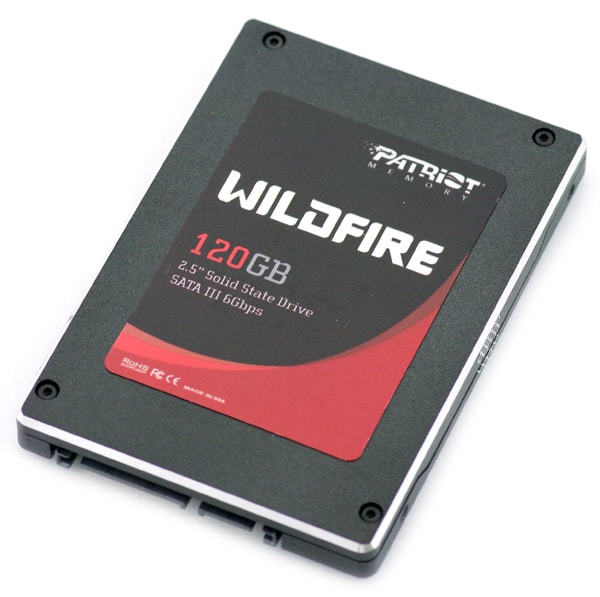
Patriot Wildfire Specs
- Formatted Capacity – 111.79GB
- SandForce SF-2281 Processor
- Toshiba 32nm Toggle NAND
- 555MB/s Read, 520MB/s Write
- 85,000 4K IOPS
- 120GB and 240GB Capacities
- Three Year Warranty
- 2.5″ Form Factor – 3.5″ Mounting Bracket Included
Aesthetics
Patriot did a pretty good job designing the Wildfire SSD, using a two-piece alloy case with a dark-grey metallic paint job. The finish is consistent over both sides of the SSD, including the bottom. The top case-half is finished off with a lightly beveled edge, adding some sparkle to the overall darker design.
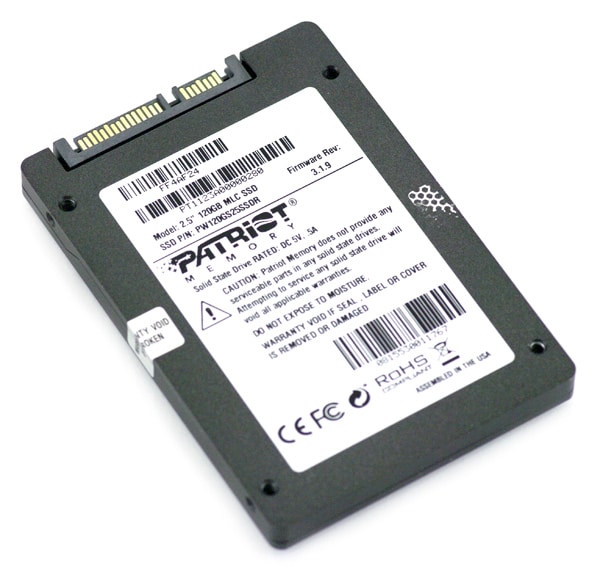
The Wildfire has a two-sticker layout, with the primary branding and capacity being listed on the top sticker and serial number and other specifics on the bottom one. The case also features two warranty-voiding stickers, which will show if you have tried to open your case.

The side profile is pretty basic, showing the horizontal screw holes and edges of both case halves where they meet in the center. You also get a glimpse of the beveled top edge cut at roughly a 45-degree angle.

The front shot is pretty basic, having only a SATA power and data connection.
Disassembly
The 120GB Patriot Wildfire is easy to take apart once you remove the warranty voiding stickers along both sides of the case. As a warning, if you want to keep your three-year warranty, don’t open up your SSD.
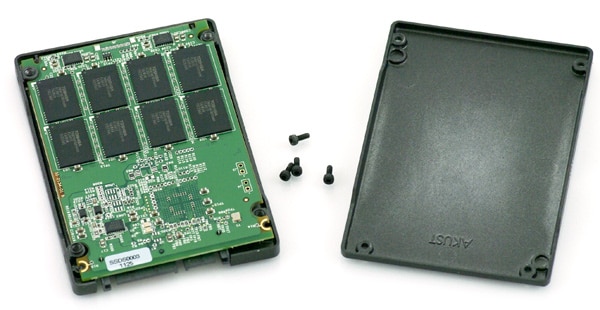
The two case halves are held together with four small Allen screws; one located near each corner on the top section of the SSD. With the screws removed and the warranty stickers cut or peeled away, the case pops open with little effort. At this point the circuit board is also loose, since it is only held in place by tension from the case halves keeping it in place.
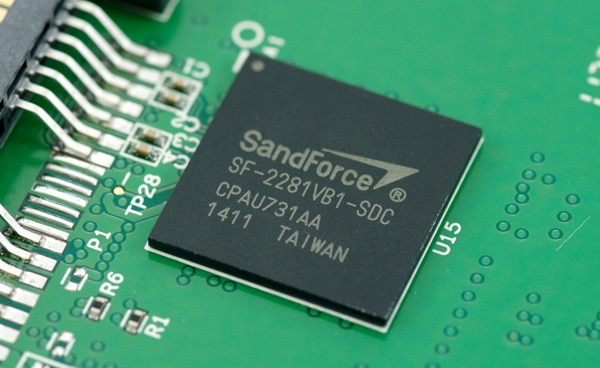
As we mentioned in the intro of this review, one very interesting aspect of the Patriot Wildfire is how it seems to have changed from the time it was first launched and reviewed to now when production models have started to ship. The model we got is part of the later group, with significant internal changes. Earlier reviewers saw models with sixteen NAND pieces, filling all available channels on the Sandforce SF-2200 processor, whereas current shipping models only offer eight chips. As a result, performance, especially when writing compressed data to the drive will be lower. We saw a similar effect take place on an 25nm OCZ Vertex 2 we reviewed earlier in the year, although on a much smaller 60GB model.
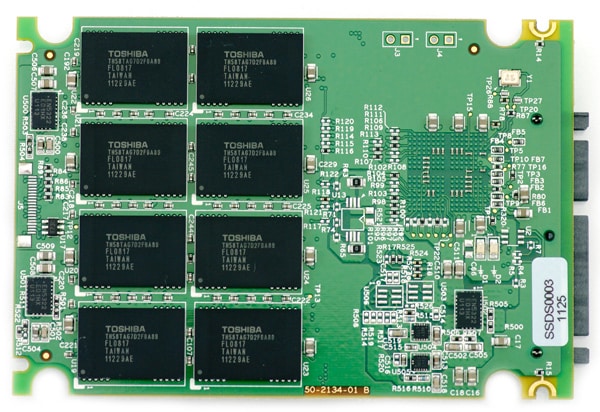
Our 120GB Wildfire includes eight Toshiba 32nm DDR Toggle NAND TH58TAG7D2FBA89 pieces and a SandForce SF-2281VB1-SDC controller. At first glance depending on which side of the PCB you look at, you might be scratching your head as to where all your NAND went.
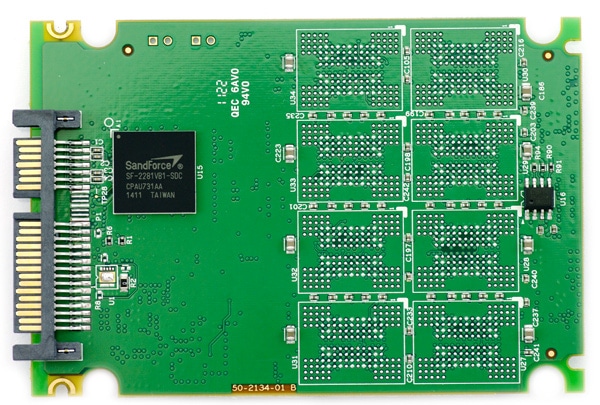
Synthetic Benchmarks
When it comes to published SSD speeds, the SATA 6Gb/s limit seems to be the limit. The Patriot Wildfire lists speeds topping 555MB/s read and write speeds of 520MB/s; right at the upper limits of the SATA III interface. to see how this drive stacks up against other SF-2200 models we have reviewed, we used IOMeter with a 2MB sequential transfer test to gauge the straight line performance of this drive.
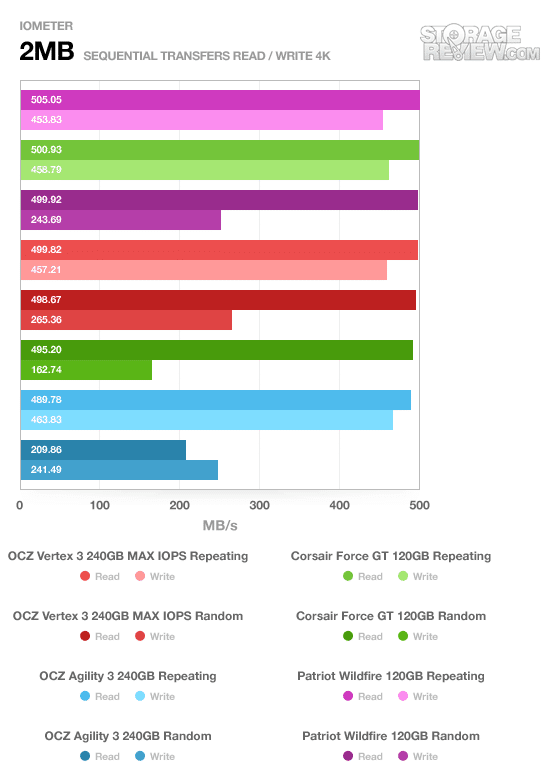
Measuring 505MB/s read and 453MB/s write with repeating data, the Patriot Wildfire led the pack with an edge of 5MB/s. With the change to fully random data, the read speeds dropped 5MB/s and write speeds lowered to 243MB/s. While still very fast on our charts, it would have been even more impressive to see how the drive handled itself with a full NAND-channel lineup.
Our next test transitions to 2MB random transfers, which for most SSDs is just as simple as a sequential load.
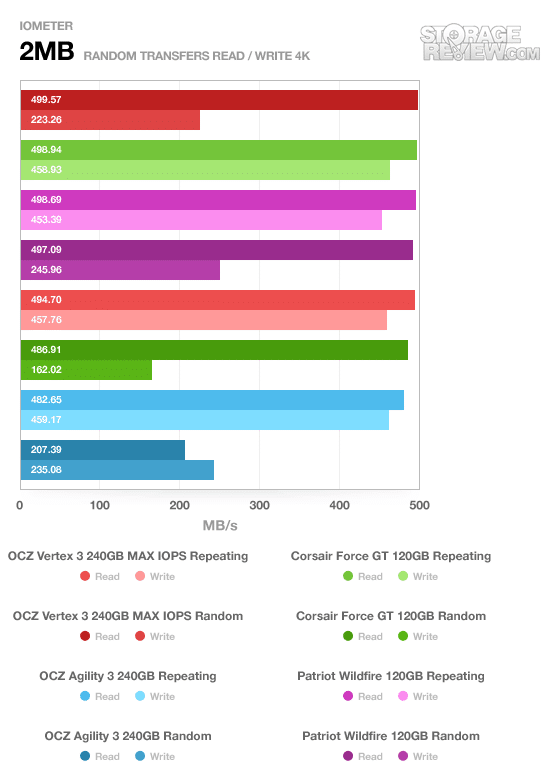
The Wildfire’s speeds dropped slightly to 498MB/s read and 453MB/s write with repeating data. Using fully randomized data the speeds lowered to 497MB/s read and 245MB/s write.
Our next section looks at 4K-aligned 4K random transfers at a queue depth of one, as well as an expanded test to a queue depth of 64.
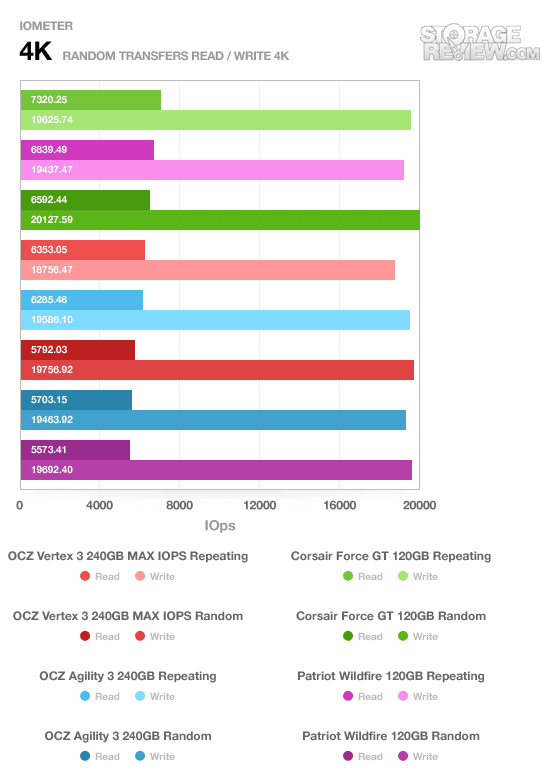
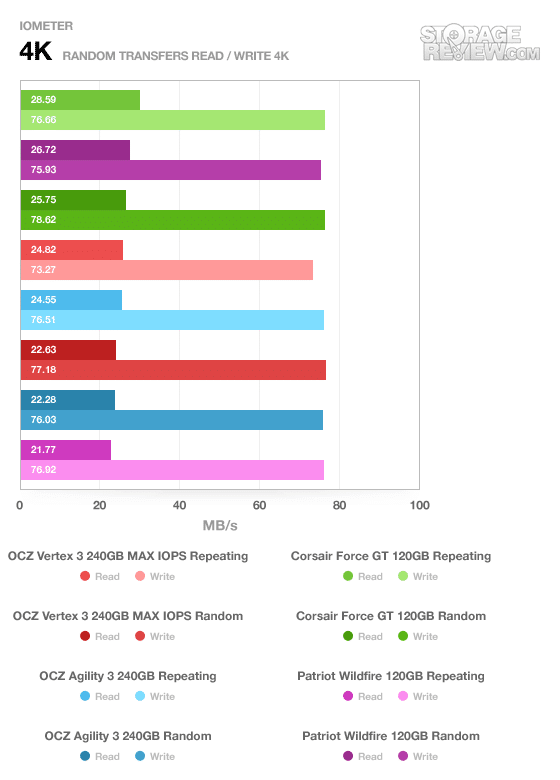
The Patriot Wildfire faired pretty well in the QD=1 4K test, with the SSD coming in 2nd place with repeating data, although dropping to last (as ranked by read speed) with incompressible random data.
Expanding the test to include increasing queue depth loads, our next set of charts cover how well drives handle higher loads. Each drive is put through its paces in this test, with 30 seconds at each interval and no recovery time in-between increases.
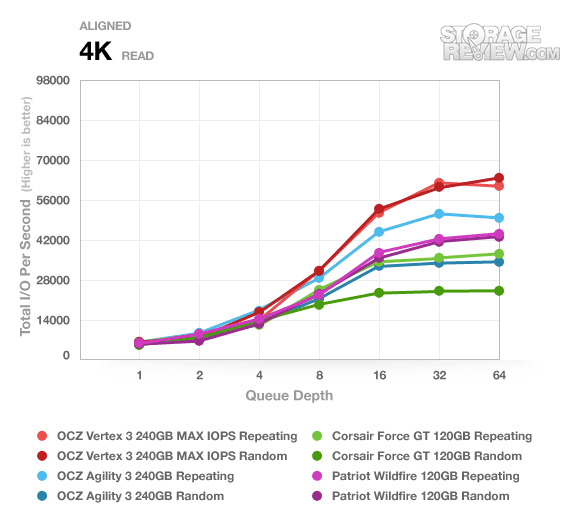
In the read portion of the expanded 4K trace, the Patriot Wildfire ranked middle of the pack with both repeating and incompressible data.
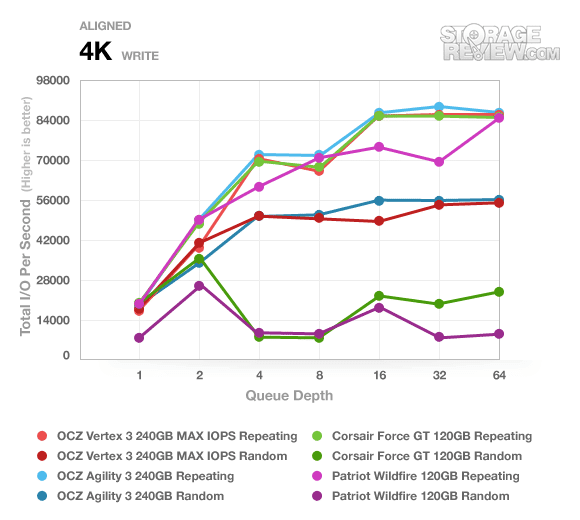
Moving to the write section, some of the limitations of the smaller capacity and fewer NAND channels became evident. With repeating data, the Wildfire just about hit its advertised spec with 84,666 IOps at its peak. With fully random data though, the Wildfire came in at the bottom of the pack, stumbling below the 120GB Corsair Force GT.
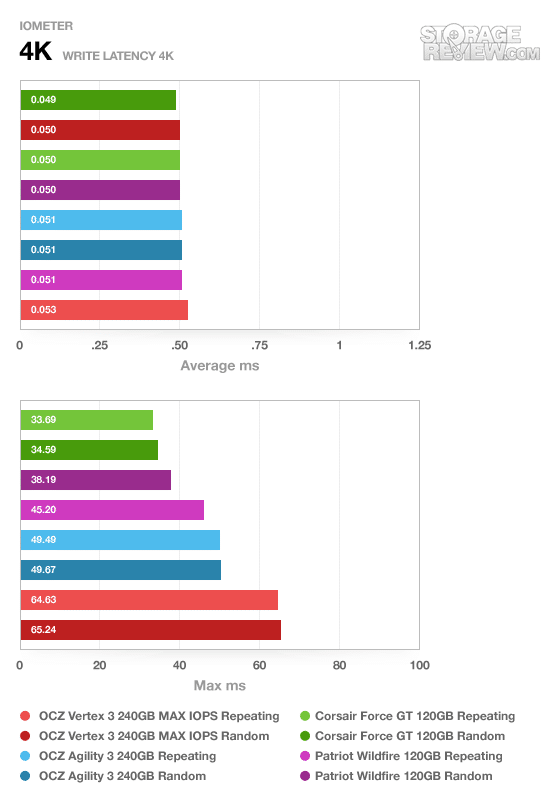
Latency was not a problem for the Wildfire, measuring 0.051ms with repeating data, and actually speeding up to 0.050ms with random data. Maximum response times varied between 38 and 45ms.
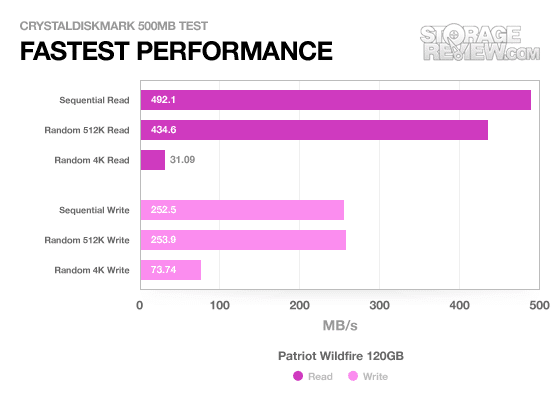
CrystalDiskMark showed very similar results to our IOMeter stats using fully random data, with read speeds just under 500MB/s and write speeds around 253MB/s.
Our last section of synthetic benchmarks uses IOMeter for industry-standard server profile tests. These cover database, file server, web server, and workstation scenarios. These tests are very useful when you are looking at the NCQ abilities of a drive as well as finding out how they perform under a heavy workload. In this area the 120GB Patriot Wildfire stayed right along with the OCZ Vertex 3 Max IOps, or led the pack when it came to the Database profile.
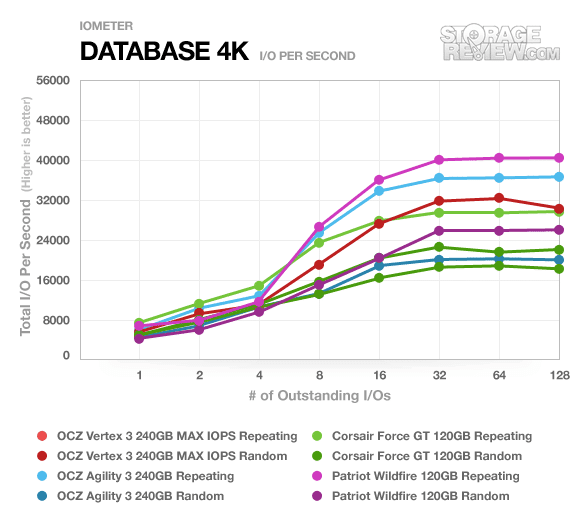
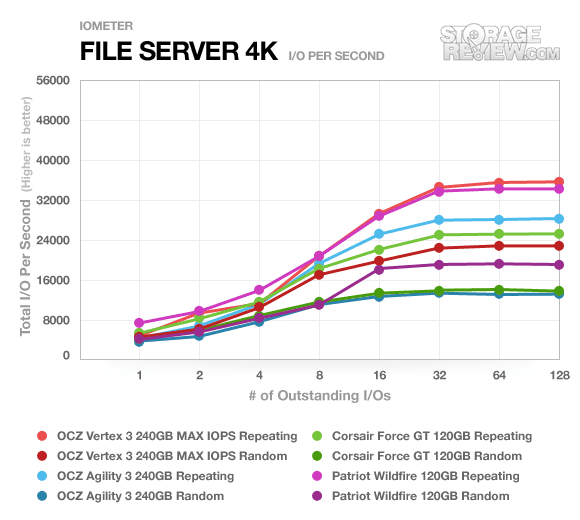
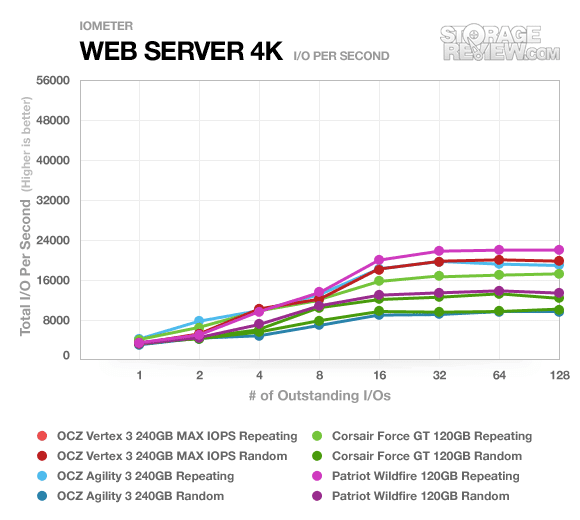
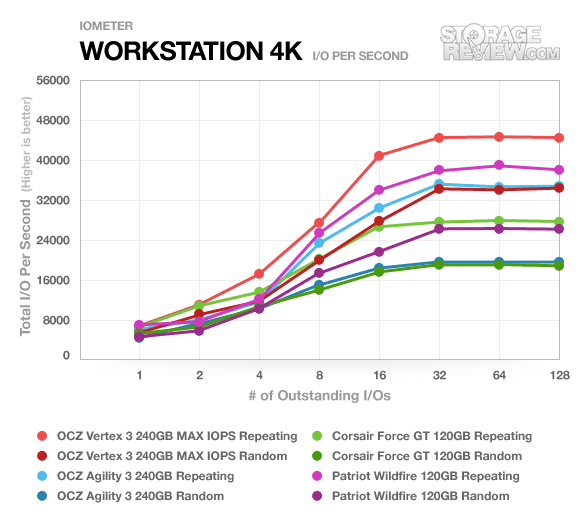
Real-World Benchmarks
If you are new to StorageReview, one thing we try to focus on is how any given drive might perform under real-world conditions. For the average user, trying to translate random 4K write speeds into an everyday situation is pretty difficult. It helps when comparing drives in every setting possible, but it doesn’t exactly work out into faster everyday usage or better game loading times. For this reason we turned to our StorageMark 2010 traces, which include HTPC, Productivity, and Gaming traces to help readers find out how a drive might rank under their conditions.
In our current lineup of SF-2200-based SSDs, it’s pretty hard to get an apples to apples comparison of the Patriot Wildfire. Its closest competitor by NAND configuration is the OCZ Vertex 3 MAX IOPS, but it has half the available flash channels, not to mention is also half the capacity. The Corsair Force GT matches the Wildfire in capacity, but has synchronous 25nm NAND instead of 32nm toggle NAND found.
The first real-life test is our HTPC scenario. In this test we include: playing one 720P HD movie in Media Player Classic, one 480P SD movie playing in VLC, three movies downloading simultaneously through iTunes, and one 1080i HDTV stream being recorded through Windows Media Center over a 15 minute period. Higher IOps and MB/s rates with lower latency times are preferred. In this trace we recorded 2,986MB being written to the drive and 1,924MB being read.
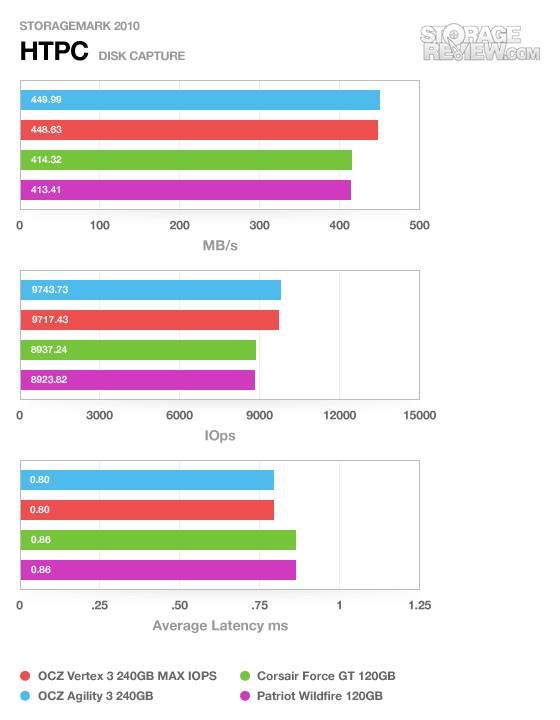
The Patriot Wildfire came in just under the Force GT in the HTPC trace, with an average transfer speed of 413MB/s. While technically “last” it still held with the pack very well.
Our second real-life test covers disk activity in a productivity scenario. For all intents and purposes this test shows drive performance under normal daily activity for most users. This test includes: a three hour period operating in an office productivity environment with 32-bit Vista running Outlook 2007 connected to an Exchange server, web browsing using Chrome and IE8, editing files within Office 2007, viewing PDFs in Adobe Reader, and an hour of local music playback with two hours of additional online music via Pandora. In this trace we recorded 4,830MB being written to the drive and 2,758MB being read.
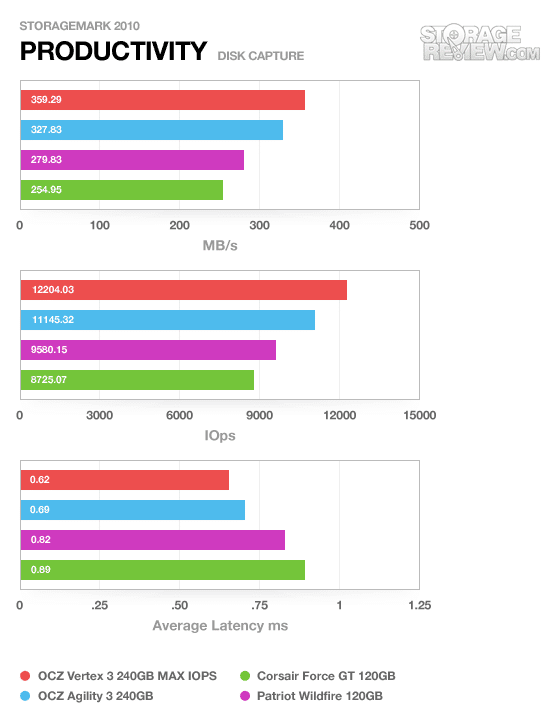
The Wildfire stepped up its game in our productivity trace, coming in ahead of the Force GT, with an average speed of 279MB/s, but still well under the 240GB models that measured 359 and 327MB/s average.
Our third real-life test covers disk activity in a gaming environment. Unlike the HTPC or Productivity trace, this one relies heavily on the read performance of a drive. To give a simple breakdown of read/write percentages, the HTPC test is 64% write, 36% read, the Productivity test is 59% write and 41% read, while the gaming trace is 6% write and 94% read. The test consists of a Windows 7 Ultimate 64-bit system pre-configured with Steam, with Grand Theft Auto 4, Left 4 Dead 2, and Mass Effect 2 already downloaded and installed. The trace captures the heavy read activity of each game loading from the start, as well as textures as the game progresses. In this trace we recorded 426MB being written to the drive and 7,235MB being read.
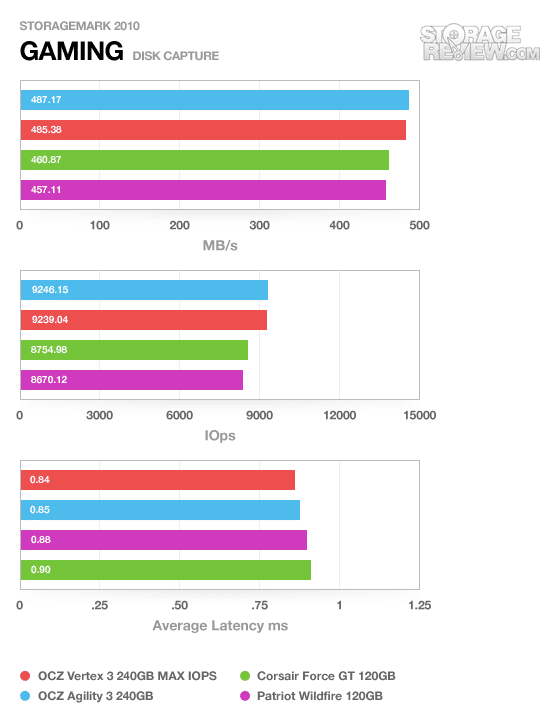
In the gaming trace the Wildfire lagged slightly behind the Force GT, with an average speed of 457MB/s. In this trace the top of the pack had an advantage of roughly 30MB/s.
Power Consumption
Patriot doesn’t list estimated power consumption of the Wildfire, so users don’t have much to go from when trying to compare this model against others. In our tests, even with the eight-chip NAND configuration, we still found the 120GB Wildfire to consume power slightly above average.
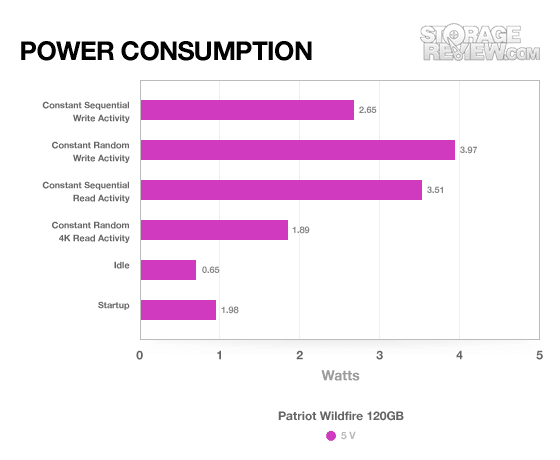
The Wildfire used 2.65 watts during a sequential write of repeating data, which jumped to 3.97 watts with fully random data. Sequential read activity was pretty high, needing 3.51 watts during our 2MB transfer test, which dropped to 1.89 watts in the 4K random read stage. Idle was pretty good, using just 0.65 watts.
Warranty
Patriot offers an industry-standard three-year warranty on the Wildfire SSD. Currently all manufacturers except Intel and OWC offer a three-year warranty. Intel and OWC have five-year warranties on select 25nm SSDs.
Conclusion
As one of the most expensive 120GB SF-2200 SSDs on the market right now, the Patriot Wildfire did prove to be quite capable. Even with early release to full production changes which included halving the number of NAND flash chips, the Wildfire still maintained strong incompressible data write speeds. With scores surpassing what we found with the Corsair GT, it does have a some advantages, but it still comes in below the chart-topping 240GB models.
Priced at $309 for the 120GB model, the Patriot Wildfire is positioned well above the 120GB Vertex 3 which is currently selling for $249 ($229 with rebate) or even the 120GB Corsair GT at $289. Its closest competitor based on specs, the Vertex 3 MAX IOPS, has the same retail price, but on sale it costs $35 with a street price of $274. Prices move around quite a bit though and we’d expect to see some downward pressure on the Wildfire in the coming weeks and months after release.
Pros
- Very quick in the 120GB capacity
- Upgraded to toggle NAND after initial press release
Cons
- Higher than normal power consumption
- Configuration changes between launch and full production
Bottom Line
The 120GB capacity drives based on the SandForce SF-2281 processor give up a little speed when compared to the 240GB pack leaders. The Patriot Wildfire held its own though, besting the 120GB Corsair GT, as we’d expect. Patriot went with top of the line components for the Wildfire making it a viable option at the popular 120GB capacity point, though you may have to pay up a little bit for the performance.
Buy The Patriot Wildfire at NewEgg.com
Patriot Wildfire 120GB
Patriot Wildfire 240GB
